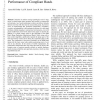Free Online Productivity Tools
i2Speak
i2Symbol
i2OCR
iTex2Img
iWeb2Print
iWeb2Shot
i2Type
iPdf2Split
iPdf2Merge
i2Bopomofo
i2Arabic
i2Style
i2Image
i2PDF
iLatex2Rtf
Sci2ools
AROBOTS
2010
2010
Contact sensing and grasping performance of compliant hands
Limitations in modern sensing technologies result in large errors in sensed target object geometry and location in unstructured environments. As a result, positioning a robotic end-effector includes inherent error that will often lead to unsuccessful grasps. In previous work, we demonstrated that optimized configuration, compliance, viscosity, and adaptability in the mechanical structure of a robot hand facilitates reliable grasping in unstructured environments, even with purely feedforward control of the hand. In this paper we describe the addition of a simple contact sensor to the fingerpads of the SDM Hand (Shape Deposition Manufactured Hand), which, along with a basic control algorithm, significantly expands the grasp space of the hand and reduces contact forces during the acquisition phase of the grasp. The combination of the passive mechanics of the SDM Hand along with this basic sensor suite enables positioning errors of over 5cm in any direction. In the context of mobile manipu...
| Added | 08 Dec 2010 |
| Updated | 08 Dec 2010 |
| Type | Journal |
| Year | 2010 |
| Where | AROBOTS |
| Authors | Aaron M. Dollar, Leif P. Jentoft, Jason H. Gao, Robert D. Howe |
Comments (0)

